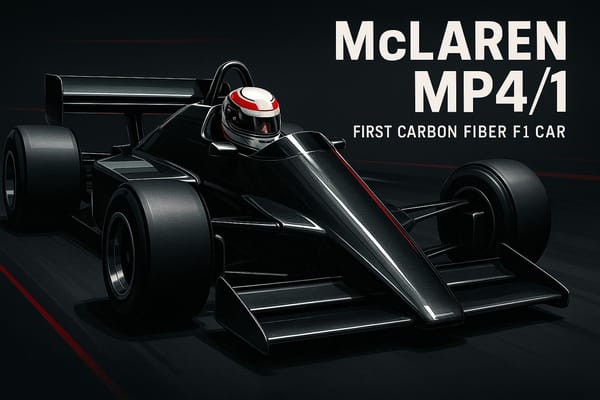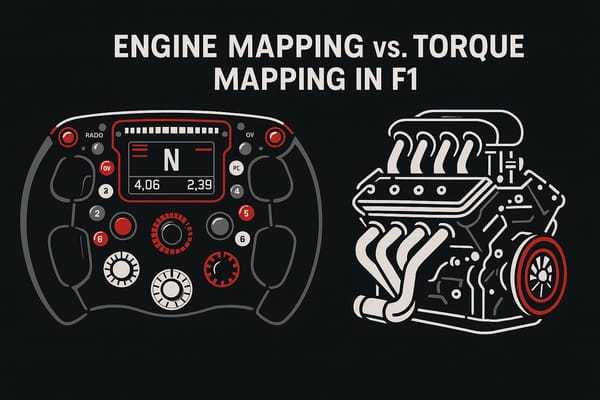Silverstone Circuit Explored: The Spiritual Home of Formula 1 and the Origins of Speed
Explore the rich history and technical challenges of Silverstone Circuit, the birthplace of Formula 1 and a symbol of motorsport innovation.

Silverstone Circuit is more than just a racetrack - it's where Formula 1 began. Hosting the first-ever World Championship race on May 13, 1950, this historic venue has evolved from a wartime airfield into one of the most iconic tracks in motorsport. Known for its high-speed corners like Copse and the Maggotts-Becketts sequence, Silverstone challenges drivers and teams with its technical demands, unpredictable weather, and fast-paced action.
Key Highlights:
- First F1 Race: Held in 1950 with King George VI in attendance.
- Record Attendance: 480,000 fans at the 2023 British Grand Prix.
- Driver Records: Lewis Hamilton holds the most wins at Silverstone (9).
- Track Evolution: From airfield runways to a modern F1 staple with ongoing safety upgrades.
- Historic Moments: From Nigel Mansell's iconic 1987 comeback to Hamilton's dramatic 2021 win after a collision with Verstappen.
Silverstone isn’t just a track; it’s a symbol of Formula 1’s history and innovation. Its legacy continues as it hosts the British Grand Prix through 2034, captivating fans and drivers alike with its unique blend of speed, strategy, and spectacle.
The Origins of Silverstone Circuit

From Airfield to Racing Circuit
Silverstone's journey from a wartime airfield to a top-tier motorsport venue began in 1947. Originally, RAF Silverstone served as a bomber station during World War II, operating from 1943 to 1947 as the base for No. 17 Operational Training Unit RAF. After the war, the United Kingdom found itself with an abundance of unused airfields but no major race tracks.
In September 1947, an informal two-mile race was held on the deserted airfield, organized by Maurice Geoghegan and his friends. This event, later nicknamed the "Mutton Grand Prix", earned its quirky title after Geoghegan accidentally collided with a sheep during the race.
The impromptu race sparked interest, and by 1948, the Royal Automobile Club (RAC) leased the airfield and turned it into a formal racing circuit. Initially, races were held on the runways with hay bales marking the track boundaries. By 1949, the circuit shifted to the perimeter roads surrounding the airfield. In 1951, the British Racing Drivers' Club (BRDC) took over the lease, beginning the transformation of Silverstone into a permanent motorsport hub. These early developments set the stage for Silverstone's historic role in Formula 1, including hosting the championship's very first race.
The 1950 British Grand Prix: Formula 1's First World Championship Race
On May 13, 1950, Silverstone achieved a milestone by hosting the inaugural Formula 1 World Championship race. This event, which also carried the title of European Grand Prix for that year, became legendary for its groundbreaking significance. Interestingly, Enzo Ferrari chose not to participate, citing dissatisfaction with the appearance fees offered by the organizers.
Approximately 200,000 spectators attended the race, showcasing Britain’s enthusiasm for premier motorsport. Among the attendees were King George VI and Queen Elizabeth, adding a royal touch to the historic day. Giuseppe "Nino" Farina claimed victory in his Alfa Romeo, completing the 70-lap, 202.213-mile race in just over two hours, with an average speed of 90.955 mph.
This landmark event not only drew huge crowds but also set a precedent for Silverstone’s role in Formula 1. It established the circuit as a cornerstone of racing history, known for its ability to adapt and grow alongside the sport.
Key Layout Changes Over the Decades
Silverstone has undergone numerous layout changes over the years to meet evolving safety standards, technological advancements, and competitive demands. These updates have allowed the track to maintain its challenging nature while ensuring the safety of drivers and spectators.
The first major safety modification came in 1975 with the addition of the Woodcote Chicane. This change was prompted by a serious crash during the 1973 British Grand Prix involving Jody Scheckter, which highlighted the dangers of the circuit’s high speeds. The chicane effectively slowed cars down, reducing the risk of similar accidents.
In the early 1990s, Silverstone underwent a significant redesign. The track was transformed from a high-speed layout into a more technical challenge. The iconic Maggotts, Becketts, and Chapel sequence was reconfigured into the demanding series of corners we know today. Additional changes included the introduction of Vale between Stowe and Club to encourage overtaking, as well as a new section featuring Bridge, Priory, and Brooklands after Abbey.
Following the tragic deaths of Ayrton Senna and Roland Ratzenberger in 1994, further safety measures were implemented. Corners like Copse, Stowe, Abbey, and Priory were adjusted to reduce speeds and expand run-off areas. A chicane was also added at Abbey after a testing accident.
In 2010, the "Arena" complex was introduced, extending the track by roughly 2,490 feet. This new section, which began at the old Abbey Chicane and rejoined at Brooklands, included additional grandstands to improve the spectator experience. A year later, the start/finish straight and pit facilities were relocated from the Woodcote-Copse area to the Club-Abbey section, modernizing the circuit and streamlining team operations.
These changes have allowed Silverstone to balance its high-speed heritage with modern safety requirements, ensuring its place as one of the most respected and challenging tracks in Formula 1.
Key Moments and Famous Races at Silverstone
Famous Driver Battles and Wins
Silverstone has been the backdrop for some of the most thrilling driver battles in racing history, often featuring standout performances by British drivers. The track’s high-speed layout, combined with its tricky corners, has set the stage for unforgettable moments of skill and rivalry.
Nigel Mansell’s performances at Silverstone are the stuff of legend. In 1987, he started 29 seconds behind his teammate Nelson Piquet but pulled off a stunning comeback, completing a daring dummy overtake at Stowe to take the win. The crowd’s reaction was electric. Mansell’s dominance continued in 1991, when he won by a massive 42 seconds and even gave Ayrton Senna a ride back to the pits after Senna ran out of fuel.
Lewis Hamilton has carved out his own legacy at Silverstone with a record-breaking nine victories. His 2008 win in torrential rain showcased his exceptional skill. Starting fourth, Hamilton overtook teammate Heikki Kovalainen and finished 68 seconds ahead of Nick Heidfeld, with only three cars completing the race on the lead lap.
The rivalry between Hamilton and Max Verstappen also reached a boiling point at Silverstone in 2021. Their intense battle led to a dramatic collision at Copse corner, where Verstappen’s car hit the barriers at 180 mph. Despite receiving a 10-second penalty, Hamilton went on to win the race, adding another chapter to the circuit’s storied history.
Jim Clark’s dominance at Silverstone in the 1960s remains iconic. Between 1962 and 1967, he won five British Grands Prix, setting a record that stood until Nigel Mansell surpassed it in the 1990s.
"Silverstone is a great track; it is of course a very historic track but also great fun. It has a lot of fast corners, Becketts and Maggots being my favorite, and there are always loads of fans out in force." – Max Verstappen
These moments of on-track brilliance have been matched by equally dramatic incidents and controversies.
Major Incidents and Controversies
Silverstone’s high-speed action has often led to controversies that have shaped the sport’s rules and rivalries.
Michael Schumacher’s clashes with the rules at Silverstone remain memorable. In 1994, he was disqualified and handed a two-race ban after delaying a penalty for an illegal pass on Damon Hill during the formation lap. Four years later, in 1998, Schumacher found himself at the center of another storm. He served a 10-second penalty under the safety car by entering the pit lane on the final lap, crossing the finish line first in a controversial move.
The 2021 Hamilton-Verstappen collision at Copse corner remains one of modern F1’s most debated moments. Verstappen’s car crashed heavily into the barriers at 180 mph, while Hamilton, despite a penalty, celebrated a hard-fought win. Verstappen later criticized the post-race celebrations, saying:
"Watching the celebrations while still in hospital is disrespectful and unsportsmanlike behaviour, but we move on." – Max Verstappen
Team drama also took center stage in 2010 when Red Bull gave a new front wing designed for Mark Webber to Sebastian Vettel. Webber went on to win the race and sarcastically declared over the radio:
"Not bad for a number two driver." – Mark Webber
In 2022, safety concerns arose when six "Just Stop Oil" protesters stormed the track during the race. The protesters were arrested and later charged with causing a public nuisance, receiving suspended sentences for their actions.
The infamous "Spygate" scandal of 2007 also had ties to Silverstone. Ferrari’s Nigel Stepney passed confidential technical data to McLaren’s Mike Coughlan, resulting in McLaren receiving a record $100 million fine.
Statistics and Records at Silverstone
Silverstone’s rich history is reflected in its impressive statistics and records.
Lewis Hamilton’s nine wins at Silverstone make him the most successful driver at the circuit, surpassing Michael Schumacher’s record for the most wins at a single track. His 2024 victory ended a long winless streak, further solidifying his dominance at the venue.
The 1950 British Grand Prix, the first-ever Formula 1 World Championship race, set the stage for the sport’s future. Giuseppe "Nino" Farina’s victory remains a cornerstone of Silverstone’s legacy.
Weather often plays a pivotal role at Silverstone, as seen in the 2008 British Grand Prix. During heavy rain, Hamilton’s masterful performance led to a 68-second winning margin, with only three cars finishing on the lead lap.
Mechanical drama has also added to the circuit’s lore. In 2020, Hamilton managed to nurse his Mercedes across the finish line on three wheels after a puncture on the final lap, showcasing the razor-thin margins between triumph and disaster.
Silverstone: Britain's Most Famous Race Track | Full Documentary | Great Circuits: Silverstone
Silverstone's Technical Challenges and Track Features
Silverstone, steeped in Formula 1 history, continues to push teams to their limits with its intense technical demands. Known for its high-speed corners and unpredictable weather, this circuit is a proving ground for both cars and drivers, where every lap is a test of endurance, precision, and strategy.
Corner Complexity: Copse, Maggotts, and Becketts
Few sections in motorsport rival the Maggotts-Becketts complex in terms of sheer difficulty. This iconic sequence subjects drivers to over 5g of lateral force, pushing both their physical limits and their car's engineering to the edge.
Copse corner is another standout challenge. Approaching at an incredible 290 kph (180 mph), drivers endure 5g of force while tire temperatures soar past 110°C (230°F). Despite the forgiving run-off area, the high speeds leave zero room for error - any misstep can be disastrous.
Interestingly, the Maggotts-Becketts sequence has evolved into what drivers now treat as a near-continuous corner. Former F1 driver Jolyon Palmer explains:
"Maggots and Becketts are pretty much one corner now because your foot is nailed down throughout. The end is not quite flat, but you're happy to compromise there to get on the right part of the track for the exit."
This section is a grueling workout for drivers, particularly their neck muscles, as they tackle these sweeping turns nearly flat-out. The left-front tire takes the brunt of the punishment, influencing tire strategies throughout the race weekend.
Impact on Car Setup and Race Strategies
With 18 turns and a layout that demands high-speed precision, Silverstone forces teams to strike a delicate balance between aerodynamic efficiency and tire preservation. Drivers spend 65% of the lap at full throttle, maintaining an average speed of 225 kph (140 mph), making setup decisions critical.
Downforce configuration plays a pivotal role here. Adding more downforce improves grip in corners but increases drag on straights, whereas reducing it risks tire wear and instability. Guenther Steiner, Haas F1 Team Principal, highlights the importance of managing this trade-off:
"The car must be stuck to the ground. As soon as you take away too much downforce, the tires won't last and you begin to have graining, which the drivers do not like. We have to take off just enough downforce so that the car doesn't slide and start going through the tires too quickly. It's less about the driver feel and more about tire preservation. The driver may be more comfortable when the tire is going away, but then you risk the chance of the tire going out."
Silverstone's abrasive surface adds another layer of complexity. Pirelli typically supplies harder tire compounds to handle the aggressive track and high-speed sections. Teams must carefully monitor tire degradation, especially on the heavily stressed left-front tire. Adding to the challenge, Pirelli's minimum tire pressure regulations can impact grip, forcing teams to fine-tune their setups.
Weather and Surface Conditions
Silverstone's ever-changing weather is another wildcard that can turn race strategies upside down. British rain is notorious for creating uncertainty, and even a modest 34% chance of rain can completely reshape a team's approach to the weekend.
When the rain does arrive, the difficulty spikes. As Peter Hall, Aston Martin's Head of Race Strategy, explains:
"Wet weather gives us the biggest challenge, but these conditions also frequently provide the most exciting races."
A wrong tire choice in wet conditions can cost drivers upwards of 10 seconds per lap, or worse, lead to race-ending incidents. Adding to the chaos, fluctuating track temperatures can drastically alter tire performance and grip levels. In such unpredictable conditions, pre-race simulations often go out the window, and real-time decision-making takes center stage. Wet races often highlight driver skill over engine power, leveling the playing field and creating some of the most unforgettable moments in Formula 1 history.
Silverstone's Legacy and Modern Impact
Silverstone as a Symbol of British Motorsport
Silverstone holds a special place in Formula 1 history as the venue for the sport's very first World Championship race. This iconic moment not only established its legacy but also set the stage for the growth of motorsport across the United Kingdom over the past seven decades.
The circuit's importance goes beyond its historical roots. It represents the essence of the sport and serves as a source of pride for British drivers and teams who view victories at Silverstone as particularly meaningful. Situated across Northamptonshire and Buckinghamshire, the track stands as a truly national venue, transcending regional divides.
Silverstone has also shaped the identity of British motorsport. Many groundbreaking engineering advancements and strategic innovations have been tested and perfected on its challenging layout. This rich history adds depth to the experience for fans and participants alike.
Fan Engagement and Atmosphere
The energy at Silverstone during race weekends is legendary, fueled by some of the most passionate fans in motorsport. With 140,000 spectators attending daily during the event, the atmosphere is electric and has earned widespread praise from drivers. British driver Lando Norris summed it up by saying:
"As a British driver racing at Silverstone it's incredible – the amount of support, the amount of people… it can be pretty surreal!"
But the Silverstone experience isn’t just about the race. Fans can immerse themselves in interactive fan zones featuring F1 car displays, racing simulators, and meet-and-greet opportunities with drivers. These activities create lasting memories and a closer connection to the sport.
The entertainment doesn’t stop there. Throughout the weekend, attendees can enjoy comedy shows, concerts, and lively afterparties. The Silverstone Museum offers a deeper dive into the circuit’s and motorsport’s rich history, adding an educational element to the excitement. With a variety of viewing options, from general admission to premium grandstands, fans can enjoy the race from multiple perspectives.
On race day, Silverstone's heliport becomes the busiest airport in the world, showcasing the event's massive scale and the lengths fans go to attend. Norris highlighted the importance of this fan enthusiasm:
"For me, the fans make the British Grand Prix what it is. I really love Silverstone as a track, but the experience itself, of the fans being there – that's what makes it so special, unique and memorable."
This unmatched support solidifies Silverstone's enduring role in the world of Formula 1.
Silverstone's Place in Modern Formula 1
Silverstone’s legacy is matched by its importance in modern Formula 1. Since becoming the permanent home of the British Grand Prix in 1987, the circuit has consistently delivered thrilling races that showcase the sport at its best.
Drivers often name Silverstone as their favorite track, thanks to its high-speed layout and challenging corners. With cars reaching speeds of up to 198 mph, the circuit pushes both drivers and machines to their limits, making for some of the most exciting racing on the calendar.
The circuit’s ability to adapt has also been key to its continued success. During the 2020 season, Silverstone demonstrated its flexibility by hosting two consecutive races due to the COVID-19 pandemic. This adaptability ensures the venue remains relevant while preserving its unique character.
With a capacity of 164,000 spectators, Silverstone is one of the largest venues in Formula 1, making the British Grand Prix a major commercial success. Event director Nick Wigley emphasized the circuit’s dedication to honoring its heritage, saying:
"We wanted something really special to honour this momentous 75th anniversary milestone and this incredible World Champions Collection will do just that. We will be paying tribute to all 34 World Champions from the past 75 years at the circuit where the Formula 1 World Championship was born – it will be incredible!"
Silverstone’s blend of history, passionate fans, and consistently thrilling races ensures its place as a cornerstone of Formula 1 for generations to come.
Conclusion: Silverstone's Lasting Impact on Formula 1
Silverstone Circuit stands as the bedrock of Formula 1's storied history. Since hosting the first-ever Formula 1 World Championship race in 1950, it has remained a pivotal part of the sport’s identity.
What began as a World War II airfield transformed into one of motorsport’s most iconic venues, mirroring Formula 1’s own evolution. The humble "Mutton Grand Prix" of 1947 grew into a global championship event, celebrated for its technical demands and emotional highs. Over the decades, the circuit’s design has evolved to match the sport’s relentless push for innovation, influencing everything from car performance to race strategies. Silverstone has become a living testament to Formula 1's heritage.
The circuit’s legacy isn’t just about records, though they are impressive - Lewis Hamilton’s lightning-fast qualifying lap of 1m24.303s in 2020 and Max Verstappen’s race lap record of 1m27.097s are prime examples. What truly defines Silverstone is the human connection. Each year, over 100,000 fans flood the Northamptonshire countryside, creating an atmosphere so electric that drivers often call it one of their favorite tracks.
Beyond the roar of engines on race weekends, Silverstone has shaped the very DNA of Formula 1. Its high-speed corners and unpredictable weather have pushed teams to refine aerodynamic designs, tire strategies, and chassis performance. The lessons learned here ripple across the entire grid, influencing how teams approach the sport.
What sets Silverstone apart is its ability to grow without losing its essence. Modern upgrades to facilities and a strong focus on sustainability prove that tradition and progress can go hand in hand. As Formula 1 expands its global reach, Silverstone remains a vital link between the sport’s storied past and its dynamic future.
Silverstone’s influence goes far beyond lap records or fan attendance. It’s etched in the unforgettable battles, the technical advancements it has inspired, and the passion it continues to ignite in fans worldwide. As long as Formula 1 exists, Silverstone will hold its place as the sport's spiritual home - a place where speed was born and where the heart of racing continues to beat.
FAQs
How did Silverstone transform from a World War II airfield into a legendary Formula 1 circuit?
Silverstone Circuit has an intriguing origin story, starting life as RAF Silverstone, a Royal Air Force bomber station established in 1943 during World War II. Its distinctive triangular layout, formed by three runways, later served as the blueprint for the early racecourse.
In 1947, after the war had ended, a group of local motorsport enthusiasts organized a casual race on the deserted airfield, humorously naming it the "Mutton Grand Prix." By 1948, the Royal Automobile Club took notice, leasing the site and converting it into an official racing circuit. Initially, the track incorporated parts of the runways and perimeter roads. Over the years, it evolved with numerous updates - modernizing corners, improving safety measures, and adding state-of-the-art facilities - ultimately becoming the prestigious Formula 1 venue it is today.
Silverstone holds a special place in motorsport history, not only for its storied past but also as the site of the very first Formula 1 World Championship race in 1950.
What technical challenges do drivers face at Silverstone, and how do these affect race strategies?
Silverstone is a track that tests drivers and cars like few others. With high-speed corners such as Maggots and Becketts, precision and aerodynamic balance are absolutely essential. These sections demand not only flawless car setup but also razor-sharp focus from the drivers to maintain control while pushing their limits.
The circuit’s layout - combining long straights with challenging turns - adds another layer of complexity. Tires take a beating here, with wear and cooling becoming major factors in race strategy. Teams need to carefully plan pit stops and manage tire performance, striking a balance between outright speed and endurance over the full race. Success often hinges on how well teams and drivers adapt to these challenges as the race unfolds.
Why is Silverstone known as the spiritual home of Formula 1, and what makes it stand out from other tracks?
Silverstone is often hailed as the heart of Formula 1, and for good reason - it was the stage for the first-ever World Championship race on May 13, 1950. Once a Royal Air Force base, this iconic circuit has hosted the British Grand Prix for decades, earning its place in motorsport history.
What makes Silverstone truly special is the way it combines its rich history with forward-thinking innovation. Its legendary high-speed corners, like Maggotts and Becketts, have tested the limits of drivers and machines alike. Beyond thrilling races, the track has played a key role in advancing racing technology, making it a symbol of F1's heritage and its constant drive for progress.
Related posts
- Monaco Grand Prix Circuit Guide: The Prestige, Precision, and Pressure of F1’s Crown Jewel
- Albert Park Uncovered: The History, Evolution, and Challenges of the Australian Grand Prix Circuit
- Suzuka’s Legacy: How Japan’s Iconic Figure-8 Circuit Became a Driver Favourite
- Spa-Francorchamps Deep Dive: The Drama, Danger, and DNA of Belgium’s Legendary Track




